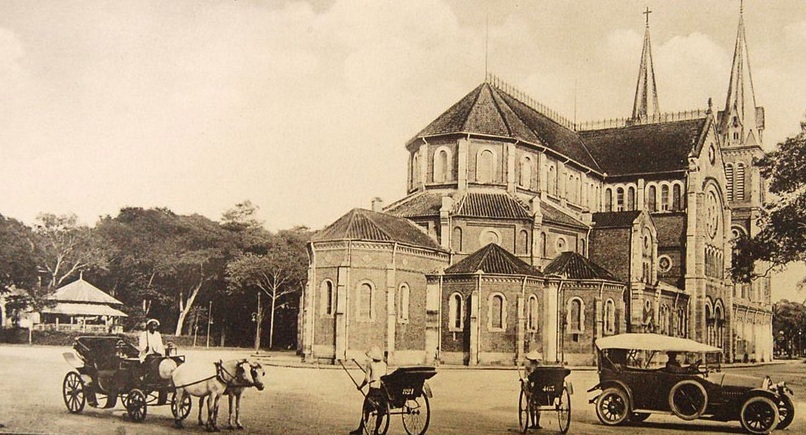An insight into the history of Ho Chi Minh City (Saigon)
Ho Chi Minh city is a young city in Vietnam. But Saigon’s 300 years of history have been both rich and eventful. Today Ho City is considered the economic capital of Vietnam. Here are some highlights of Saigon’s history.

Before being called Saigon
The site has been inhabited since prehistoric times, as evidenced by the remains
found during the foundation works of its cathedral. Several times throughout its history, the city has come under Khmer’s influence. It took its Vietnamese name of Saigon only in the 18th century. Saigon would mean ouatier wood – or kapok, a tree from this region.
At the beginning of the 15th to the 18th century
Further back in the history of Saigon, from the end of the 15th century, the first Annamites settled spontaneously on this land known as very fertile land. A new wave of immigration intensified between 1623 and 1698. Then right next to it, Cho Lon attracted the first foreign immigrants: Chinese fleeing the Minh dynasty settled, creating the first dynamic commercial hub in the region.
The Annamites, who traded, called the upper town, Phan-Yen, and the more commercial riverside part, Bên Thành. The city was also named Prei Nokor, which means “capital of the forest”, because of the vegetation in the middle of which it had been built.
In the 1700s, the city was just a small river port. However, the place was then beginning to make itself known as a cosmopolitan land. On which lived inhabitants with very different origins (Khmer, Cham, Chinese, Indian, Viet). At the center of these last march movements towards the South, the Nguyen lords sitting in the center of the country played an important role.
When the Nguyen dynasty had unified along with Vietnam from North to South after having overthrown the rebellious brothers of Tay Son, Saigon became, following an order of the first emperor of this dynasty, the citadel of Gia Dinh.
Key dates
– 1859
The citadel of Gia Dinh was occupied by the French military, becoming the seat of the French colony in Cochinchina. Saigon’s profile kept changing. The French were beginning to develop the city in a French style. The name “ City of Saigon ” dates from this period.
– 1867
A major event in the history of Saigon, Cochinchina became a French colony and Saigon then played the role of an important administrative, military, and economic center… of this land.
Even if French colonization brought architectural and environmental improvements such as the sanitation of marshes, plantations, and modern constructions, Saigon experienced many periods of unrest: the dismissal of Emperor Bao Dai, and the seizure of power by Ngô Dinh Diêm, and the raids….
– From 1954 to 1975
Saigon was entering a turbulent period, between the pro-American forces of Diem, those of Bao Dai, the last Vietnamese king, and those in favor of Ho Chi Minh, the leader of the Democratic Republic of Vietnam. In 1955, Ngô Đình Diệm and his pro-American positioning succeeded in ousting Bao Dai from power to reign over Saigon. The capital of the Republic of Vietnam becomes a pro-American regime.
the Americans endowed the South with architectural achievements such as
the Reunification Palace, the Palace Hotel or the American Embassy. Despite the covetousness, it has always aroused and the frequent bombardments that alternated with attacks, the city has managed to preserve its heritage, which has remained almost intact.
– Between 1965 and 1975
Saigon was at the center of disputes and shifts in power. In 1973, following the Paris Agreement, Saigon saw the withdrawal of American troops. The year 1975 witnessed the fall of the pro-American regime and adopted the name “Ho Chi Minh City”, a tribute to a man who embodied the national salvation and the territorial unity of the country.
– Since 1975
Named Ho Chi Minh City since 1975, it is administered like other Vietnamese cities by a single regime. For more than twenty years of renewal, Ho Chi Minh City and Hanoi have become the two most economic centers of the country. Ho Chi Minh City, in the eyes of the Vietnamese, still embodies modernity, dynamism, vitality, a locomotive of the national economy.
-Nowadays

At rush hour, the city experiences anarchic traffic swarming with motorbikes and increasingly long queues of cars. On Saturday evening, the streets and parks are invaded by young people, for whom it is their day out. The city is filled with overflowing energy.
It is effervescent, bubbling, open to everything, to everyone. Returned to itself since the opening, it does not shrink from any change. Delusions of grandeur are on their way.
A sense of urgency has taken hold of the city: it is necessary to catch up with its Thai and Singaporean neighbours…
With the southern provinces, Ho Chi Minh City forms “a growth triangle” playing a driving role in the country’s economic dynamism. and contributing nearly 50% of Vietnam’s GDP, 60% of industrial production and 60% of exports. The zone’s GDP growth rate is much higher than the country’s average.
If you want to know more about the history of Vietnam, please see our dedicated article here!
